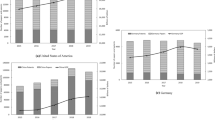Abstract
Research and development efforts are underway to provide structural health monitoring systems for future high-speed aerospace vehicles. A critical element of these vehicles is the thermal protection system (TPS). This article presents analytical and empirical results to demonstrate the feasibility of detecting loose fasteners in a TPS consisting of a carbon-carbon panel and a metallic backing structure. Analytical results show that mode shapes and resonant frequencies of the panel are functions of the fastener torque values. Empirical results from the TPS show that measured vibrational responses are useful for determining fastener failures.
Similar content being viewed by others
References
“Operation of the Defense Acquisition System,” DoD Instruction 5000.2, Section 3.9.4.2.1 (12 May 2003), www.dtic.mil/whs/directives/corres/pdf2/i50002p.pdf, accessed 17 July 2003.
“System Requirements Document for a Military Spaceplane System,” Military Spaceplane System Technology Program Office, Version 4.2 (WPAFB, OH: Air Force Research Laboratory, 12 February 2001).
M. Derriso et al., “Integrated Vehicle Health Management: The Key to Future Aerospace Systems,” Proceedings of the Fourth International Workshop on Structural Health Monitoring, ed. Fu-Kuo Chang (Stanford, CA: Stanford University, 2003), pp.3–11.
“Integrating Vehicle Concepts and Critical Technologies for High-Speed Aerospace Vehicles,” www.afrlhorizons.com/Briefs/Sept02/VA0210.html, accessed 8 August 2003.
C.R. Farrar and H. Sohn, “Pattern Recognition for Structural Health Monitoring” (Paper presented at the Workshop on Mitigation of Earthquake Disaster by Advanced Technologies, Las Vegas, NV, Nov. 30–Dec. 1, 2000).
P. Stoica and R. Moses, Introduction to Spectral Analysis (Upper Saddle River, NJ: Prentice Hall, 1997).
M. DeSimio et al., “Structural Health Monitoring Experiments with a Canonical Element of an Aerospace Vehicle,” Proceedings 2003 IEEE Aerospace Conference, ed. IEEE Press (Piscataway, NJ: IEEE, 2003), 7.3105–7.3112.
Author information
Authors and Affiliations
Additional information
Editor’s Note: Presentation of this paper is supported by the Air Force Research Laboratory, under agreement number F33615-01-D-5801. The U.S. Government is authorized to reproduce and distribute reprints for governmental purposes notwithstanding any copyright notation thereon. The views and conclusions contained herein are those of the authors and should not be interpreted as necessarily representing the official policies or endorsements, either expressed or implied, of the Air Force Research Laboratory or the U.S. Government.
For more information, contact Mark Derriso, AFRL/VASA, 2790 D. Street, WPAFB, OH 45433; (937) 904-6876; fax (937) 255-6210; e-mail Mark.derriso@wpafb.af.mil.
Rights and permissions
About this article
Cite this article
Derriso, M., Braisted, W., Rosenstengel, J. et al. The structural health monitoring of a mechanically attached thermal protection system. JOM 56, 36–39 (2004). https://doi.org/10.1007/s11837-004-0030-9
Issue Date:
DOI: https://doi.org/10.1007/s11837-004-0030-9




